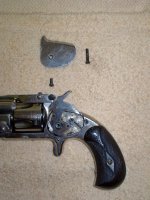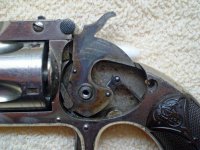This leads me to the question- does anyone have a picture of the machine tools (mill/lathe) that these were being produced on in 1879? It seems like nice surface finishes and tolerances for such a date. Very fascinating.
Howdy
Excellent question! A lot of folks today do not realize the tremendous precision that was possible with 19th Century manufacturing methods. Many assume that modern CNC equipment was needed to produce something with high precision. The firearms industry in New England, particularly in the Connecticut River valley, was key to developing methods and machinery that later found their way into many aspects of modern manufacturing.
A little bit more than 100 miles north of the Smith and Wesson factory in Springfield Mass there is a little museum in Windsor Vermont. Today it is called the American Precision Museum, but at one time it was the Robbins and Lawrence Armory.
Many of the tools and machinery first developed at Robbins and Lawrence were later used, and improved on, by all the major arms makers.
Here are a few photos.
This rifle was called the Mississippi Rifle. Robbins and Lawrence was mass producing this rifle in 1841.
The key to Robbins and Lawrence's success was pattern following equipment. This is a wood inletting machine. The work piece was mounted to a movable table that also had a pattern mounted to it. The metal jig at the bottom of the photo is the pattern. The spindle of the cutter and a stylus were rigidly fixed together from overhead. The operator used a pair of cranks to move the table, keeping the stylus in contact with the contours of the pattern. This moved the table so that the cutter would then make the appropriate cuts in the stock. Using equipment like this, the factory could turn out dozens of stocks in one day. Previously it would have taken a stock maker hours to inlet just one stock.
Robbins and Lawrence also used profiling cutters. A profiling cutter could cut a complex shape in one pass. This is the profiling cutter used for the lock plate of the Mississippi Rifle. The work piece was advanced through the cutter and the shape was cut in one pass.
This is a profiling machine used for cutting metal. The operation is similar to the wood inletting machine.
To give you a good idea of how it worked and what the entire machine looked like, I photographed the illustration that was next to the machine.
Now, as I said, this equipment was being used as early as 1841. At this time many factories were still dependent on water power, however steam power soon replaced water because it was more dependable, and more manufacturing capacity was possible with steam power.
Interestingly enough, both Daniel Wesson and Horace Smith were employed at Robbins and Lawrence before they began their partnership in 1857. Incidentally, so was B. Tyler Henry, the designer of the Henry rifle. Clearly, Robbins and Lawrence was an early hotbed of manufacturing expertise and these men, along with a few others, were able to take the concepts developed at Robbins and Lawrence and use them in their own factories.
I do not have any photos of the actual equipment used at S&W, but I am sure it was very similar in concept to what was used at Robbins and Lawrence in the 1840s. I would suspect that perhaps it was scaled down a bit for making small frame revolvers.
Using a profiling machine required considerable skill on the operator's part. He needed to coordinate turning the wheels to keep the stylus in contact with the edge of the profile. Here is a photo of the machining of the frame of a S&W Model 1 1/2. You can clearly see where the operator first plunged the cutter down into the part to the right of the barrel stud. This plunge cut is actually a few thousandths deeper than the surrounding surfaces. Then you can see where the cutter traveled up and to the left. These are mostly clearance cuts, so great precision is not necessary.
Most likely, different cuts would be done on different machines with different set ups. The same workman would stand at the same machine all day long, making the same cut over and over again. Then the part would be passed to the next machine for the next operation.
The most precise cut is the outermost cut that defines the space where the side plate fits. What is really interesting is there are chatter marks on this cut and on the mating surface of the side plate. I see no sign of hand fitting. In fact, there is still a slight burr on these cuts. To me that means that these parts were finished when they came off the pattern cutting machines. The fit was precise and no hand fitting was needed. Very impressive if you have ever removed the side plate from a S&W. Clearly tool wear and pattern wear would have to be taken into account to keep these cuts precise.
If you want to learn more about the American Precision Museum, here is their website:
American Precision Museum - Home











